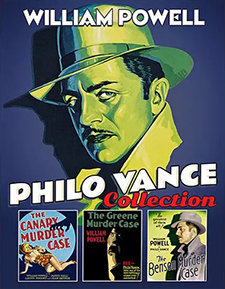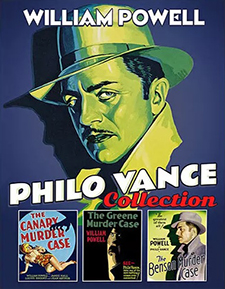Philo Vance Collection (Blu-ray Review)

Director
Malcolm St. Clair/Frank TuttleRelease Date(s)
1929-1930 (May 21, 2024)Studio(s)
Paramount Pictures (Kino Lorber Studio Classics)- Film/Program Grade: B
- Video Grade: B+
- Audio Grade: B
- Extras Grade: B
Review
Not as well remembered as other literary and screen sleuths, Philo Vance was the dapper amateur detective of 12 crime novels by writer S.S. Van Dine (Willard Huntington Wright), published during 1926-1939. Film versions of Dine’s novels were especially popular in the late ‘20s and early-to-mid ‘30s, eleven of which were made prior to 1940, the last four (to date) released in 1947 with none since. William Powell was the first to play him, in four of the first five films, the first three produced by Paramount Pictures and collected in the Philo Vance Collection by Kino: The Canary Murder Case, The Greene Murder Case (both 1929), and The Benson Murder Case (1930). Powell himself disliked playing the character, though he would reprise the role for The Kennel Murder Case (1933), made later at Warner Bros. In other films actors as varied as Basil Rathbone, Warren William, Paul Lukas, Edmund Lowe, and Alan Curtis played him.
The first entry, The Canary Murder Case, is more fascinating than entertaining. Paramount shot it as a silent film during September-October 1928, a full year after the part-talkie The Jazz Singer had wowed audiences but, more importantly, just as the impact of The Lights of New York, the first all-talking feature released two months before, was being felt. Except for the rapidly decreasing theaters still showing silent movies, it was clear that talkies were here to stay, and that silent films were no longer commercially viable.
And so, like a number of Hollywood features shot silent, it was retooled into a talking picture. Establishing shots and primarily visual sequences with little or no dialogue were retained for the sound version, with scattered lines here and there dubbed into the silent footage. There was a special problem on The Canary Murder Case, however. Prominent in the first third of the story is silent screen icon Louise Brooks, who was fed up with Hollywood, left Paramount over a salary dispute, and refused to come back to shoot new scenes or even dub her silent footage, choosing instead to leave for Germany to make Pandora’s Box and Diary of a Lost Girl. Returning to Hollywood, she was effectively blacklisted for her defiance.
Yet with Brooks still being a big star, for Canary, the producers opted to retain her scenes, briefly using a double for a handful of shots, and hired actress Margaret Livingston (Sunrise) to dub her dialogue. Though the synchronization is surprisingly good, the voice doesn’t match anything like audiences imagined Brooks speaking voice would be—it borders on Lina Lamont from Singin’ in the Rain—and it just doesn’t fit.
Even worse, this early talkie has all the telltale signs of a typical Dawn of Sound feature. Shots are static and overly long in the reshot talking scenes, the acting and pacing are sluggish and slightly off throughout, as Hollywood was still adjusting both technologically and aesthetically to the subtle differences between silent and sound movie storytelling. Like a lot of early talkies (well into the mid-1930s on many Bs), music is limited to the opening and closing titles only, with no underscoring for the rest of the film. Further, there are NO added sound effects at all, so in the silent footage retained for the talkie version, car doors slam without making a sound, one character is murdered with no sound at all heard during the struggle, etc. Just dead (and deadly) air.
All this works against what otherwise is a pretty decent mystery. Margaret O’Dell (Brooks) is the Canary, headliner of a musical revue and also a blackmailer and gold-digger of rich men besides. Jimmy (James Hall), son of wealthy industrialist Charles Spotswoode (Charles Willis Lane), has broken off his affair with the Canary to reconcile with fiancée Alice La Fosse (Jean Arthur), but the Canary is having none of that, threatening to “sing” by publicly accusing Jimmy of embezzlement. Simultaneously, she makes demands of more expensive gifts from Charles Cleaver (Lawrence Grant), toothy married man Mannix (Louis John Martels), and paranoid Teutonic Dr. Ambrose Lindquist (Gustav von Seyffertitz), all of whom make an appearance in or immediately outside the Canary’s apartment.
When she’s found strangled the next morning, District Attorney F.X. Markham (E.H. Calvert) enlists the aid of amateur sleuth Philo Vance (William Powell), also the elder Spotswoode’s close friend, Vance having helped them previously on The Greene Murder Case, making this, narratively at least, a sequel to that follow-up. Uncouth police Sgt. Heath (Eugene Pallette) is initially wary of Vance’s methods, more psychological in nature, but quickly latches onto the dapper detective once he starts producing results.
The sluggish, overly talky talkie has some good points; the offbeat last act becomes a how’d-he-do-it rather than a whodunnit, the murderer identified a couple of scenes before the end. Though Powell may have disliked playing Philo Vance, he nevertheless has about 85% of his screen persona in place, making this an interesting comparison to his later Nick Charles in MGM’s Thin Man movies. Jean Arthur, by her own admission, was a pretty bad actress in those early talkies, this one included, though instantly recognizable because of her signature voice and tiny frame. And though badly dubbed, Louise Brooks is undeniably captivating whenever onscreen.
Somewhat better, The Greene Murder Case again is set primarily in a semi-spooky mansion with a limited number of characters, and in this case the identity of the murderer is fairly obvious. Invalid Mrs. Tobias Greene (Gertrude Norman, born in 1848!) is the elderly matriarch of the family, whose children are all greedy and spoiled save for devoted caretaker Ada Greene (Jean Arthur again). One evening around the New Year during heavy snowfall, Ada’s brother Chester (Lowell Drew) is shot dead and Ada is shot in the back but survives. (In this pre-Code release, when Chester is shot blood spreads visibly from underneath his shirt, and there’s a fair amount of blood visible when Ada falls also, something unthinkable in classical Hollywood films made after mid-1934.)
Suspects include Sibella Greene (Florence Eldridge, Mrs. Frederic March), Dr. Arthur Von Blon (Ullrich Haupt), Rex Greene (Morgan Farley, later prolific on television and impossibly young here), Sproot the butler (Brandon Hurst), and German cook Gertrude Mannheim (Augusta Burmeister). Once again, Dist. Attorney John F.X. Markham (E.H. Calvert) calls on Philo Vance (Powell) to assist in the investigation, aided by Sgt. Heath (Eugene Pallette), all reprising their roles from Canary. (The film contradicts the first with mention of the Canary Murder Case occurring before this one.)
Overall, The Greene Murder Case is the best of the three. Directed by Frank Tuttle (This Gun for Hire), it’s much more visually interesting, with impressively moody cinematography and camera angles and movements, though still pretty creaky technologically. Somebody figured out that actors weren’t required to face the camera while speaking, so there are an inordinate number of shots with at least one character with his/her back to the camera. This is sometimes effective, but the production’s sound engineers still haven’t quite mastered the art of microphone placement: some voices are clearly heard, others aren’t.
William Powell performance steadily improves with each entry; he’s a much smoother talker here, more Nick Charles-like in his speech and mannerisms, though Jean Arthur is still dreadful, stiff and inexpressive. It’s rather amazing Arthur was able to improve so dramatically and quickly; by the mid- to late-1930s, she had become one of the best American actresses in cinema, but you’d never imagine that watching her here.
The most notable thing about The Greene Murder Case is an incredible set of a corner of the Greene Mansion exterior, often shot from a high angle looking down on it, once in what resembles a zoom shot: its rooftop garden, three floors high, looking over a moat-like waterway with broken ice floes. It’s not clear, at least to me, whether this was built on a massive soundstage or outdoors on the Paramount backlot, but Tuttle’s camera angles make it believable and there are several impressive stunts on that set during the admirably tense climax.
The third and final Paramount/Powell entry, The Benson Murder Case, is less an early talkie and more visually fluid, though unfortunately (and surprisingly) it has the weakest audio, which at times is garbled as if the actors were speaking underwater. For all three films I resorted to using the optional English subtitles, which helped enormously, though even these aren’t quite perfect, with some dialogue unintelligible even to the subtitler or incorrectly transcribed. (“Of course” incorrectly becomes “I’ll call,” for instance, and the Greene murders mentioned here become “Green murders.”) None of the films, incidentally, have any location scenes to speak of, relying instead on rear-screen process shots and a couple of backlot exteriors, making this trio of features feel rather claustrophobic.
Released in April 1930, this entry, deviating far from the original novel, is timely as Hell, opening with the October 24, 1929 Wall Street Stock Market crash. The crash has bankrupted or nearly bankrupted gangster Harry Gray (William “Stage” Boyd); gigolo Adolph Mohler (Paul Lukas) and his matronly patron, Paula Banning (May Beatty); and platinum blonde Broadway actress Fanny Del Roy (Natalie Moorhead); all clients of crooked stockbroker Anthony Benson (Richard Tucker). When he’s murdered at his luxurious country estate—where all of the suspects happen to have turned up, Dist. Attorney Markham (Calvert), Sgt. Heath (Pallette), and Philo Vance (Powell) are all once again on the case.
This is a more routine entry, leaning heavily on an implausible means to commit murder and like The Greene Murder Case, it’s easy to guess the murderer’s identity long before the dénouement. More interesting is the cast, including William “Stage” Boyd, whose multiple arrests for drug and alcohol possession nearly ruined the career of the other William Boyd (later of Hopalong Cassidy) fame when news stories of “Stage” would be accompanied by photos of the wrong Boyd. Also in the cast is Mischa Auer, whose eccentric persona as hangers-on high society families (as in My Man Godfrey) was not yet in place.
Kino’s Philo Vance Collection puts all three films onto a single disc, not unreasonable given their running times of 82, 65, and 69 minutes. Though touted as “brand new HD masters—from 4K and 2K scans of the best available 35mm film elements,” the quality of these film elements varies greatly from reel to reel, even within reels. Some of these elements are impressively sharp while other bits are scratched-up and worn. Presented in 1.20:1 aspect ratio, all utilized the Movietone optical sound-on-film system rather than the concurrent, inferior sound-on-disc system, but the audio is still only marginally acceptable. (One wonders to what extent, if at all, sound levels were cleaned-up, adjusted and tweaked during the DTS-HD Master Audio conversion to make them more uniform and understandable. Not much, I suspect.) As mentioned above, the optional English subtitles are especially helpful in making out the hard-to-understand dialogue. Region “A” encoded.
Supplements are limited to one commentary track for each film: Kim Newman and Barry Forshaw tackle the first two films, while Jason A. Ney can be found on the third picture.
While visually and aurally still far from perfect, Philo Vance Collection offers three early talking pictures in a watchable form, looking and sounding better than they probably have in more than nine decades. The films are as much curiosities as entertainments, but deliver on those terms. Recommended.
- Stuart Galbraith IV

